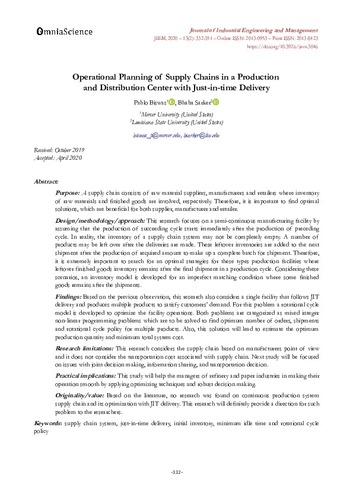Mostra el registre d'ítem simple
Operational planning of supply chains in a production and distribution center with just-in-time delivery
| dc.contributor.author | Biswas, Pablo |
| dc.contributor.author | Sarker, Bhaba |
| dc.date.accessioned | 2020-09-07T07:13:18Z |
| dc.date.available | 2020-09-07T07:13:18Z |
| dc.date.issued | 2020-07 |
| dc.identifier.citation | Biswas, P.; Sarker, B. Operational planning of supply chains in a production and distribution center with just-in-time delivery. "Journal of Industrial Engineering and Management", Juliol 2020, vol. 13, núm. 2, p. 332-351. |
| dc.identifier.issn | 2013-0953 |
| dc.identifier.uri | http://hdl.handle.net/2117/328435 |
| dc.description.abstract | Purpose: A supply chain consists of raw material suppliers, manufacturers and retailers where inventory of raw materials and finished goods are involved, respectively. Therefore, it is important to find optimal solutions, which are beneficial for both supplier, manufacturer and retailer. Design/methodology/approach: This research focuses on a semi-continuous manufacturing facility by assuming that the production of succeeding cycle starts immediately after the production of preceding cycle. In reality, the inventory of a supply chain system may not be completely empty. A number of products may be left over after the deliveries are made. These leftover inventories are added to the next shipment after the production of required amount to make up a complete batch for shipment. Therefore, it is extremely important to search for an optimal strategies for these types production facilities where leftover finished goods inventory remains after the final shipment in a production cycle. Considering these scenarios, an inventory model is developed for an imperfect matching condition where some finished goods remains after the shipments. Findings: Based on the previous observation, this research also considers a single facility that follows JIT delivery and produces multiple products to satisfy customers’ demand. For this problem a rotational cycle model is developed to optimize the facility operations. Both problems are categorized as mixed integer non-linear programming problems which are to be solved to find optimum number of orders, shipments and rotational cycle policy for multiple products. Also, this solution will lead to estimate the optimum production quantity and minimum total system cost. Research limitations: This research considers the supply chain based on manufacturers point of view and it does not consider the transportation cost associated with supply chain. Next study will be focused on issues with joint decision making, information sharing, and transportation decision. Practical implications: This study will help the managers of refinery and paper industries in making their operation smooth by applying optimizing techniques and robust decision making. Originality/value: Based on the literature, no research was found on continuous production system supply chain and its optimization with JIT delivery. This research will definitely provide a direction for such problem to the researchers. |
| dc.format.extent | 20 p. |
| dc.language.iso | eng |
| dc.publisher | OmniaScience |
| dc.rights | Creative Commons Attribution-NonCommercial 4.0 International |
| dc.rights.uri | https://creativecommons.org/licenses/by-nc/4.0/ |
| dc.subject | Àrees temàtiques de la UPC::Economia i organització d'empreses |
| dc.subject.lcsh | Business logistics |
| dc.subject.lcsh | Inventory control |
| dc.subject.other | Supply chain system |
| dc.subject.other | Just-in-time delivery |
| dc.subject.other | Initial inventory |
| dc.subject.other | Minimum idle time and rotational cycle policy |
| dc.title | Operational planning of supply chains in a production and distribution center with just-in-time delivery |
| dc.type | Article |
| dc.subject.lemac | Logística (Indústria) |
| dc.subject.lemac | Gestió d'estocs |
| dc.identifier.dl | B-28744-2008 |
| dc.description.peerreviewed | Peer Reviewed |
| dc.rights.access | Open Access |
| local.citation.publicationName | Journal of Industrial Engineering and Management |
| local.citation.volume | 13 |
| local.citation.number | 2 |
| local.citation.startingPage | 332 |
| local.citation.endingPage | 351 |


